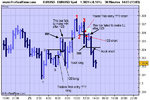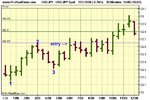dr_d_michaelson
Junior member
- Messages
- 23
- Likes
- 3
Most interesting and promising thread, Roberto. Well done and thank you.
I will be a regular reader and probably occasional contributor. As you know, I've been trading 1-2-3-formations and Ross-hooks and little else for many years now. (Will I get shot down for trying to introduce the Ross "Camelback Technique" here? I think you don't like indicators? I'll wait a while anyway.)
The comments about the confusion in nomenclature surprised me. I've always perceived them the way round you originally described them in your initial post. However, a look around the internet (I no longer have my copies of the Ross books here!) has just shown me that that ain't necessarily so. Different people describe Ross-hooks and Reverse Ross-hooks in some diametrically opposite ways! None of this is of any practical consequence at all, of course, but it will help with the discussion if everyone is singing from the same song sheet, so it would be great if you could maybe post a formal definition from the Original Source as you mentioned.
I'm looking forward to the discussion of what actually causes these formations, what the markets are doing, how the buying and selling pressures are interacting and producing these trading opportunities from which some of us make a living.
More power to your elbow.
David
I will be a regular reader and probably occasional contributor. As you know, I've been trading 1-2-3-formations and Ross-hooks and little else for many years now. (Will I get shot down for trying to introduce the Ross "Camelback Technique" here? I think you don't like indicators? I'll wait a while anyway.)
The comments about the confusion in nomenclature surprised me. I've always perceived them the way round you originally described them in your initial post. However, a look around the internet (I no longer have my copies of the Ross books here!) has just shown me that that ain't necessarily so. Different people describe Ross-hooks and Reverse Ross-hooks in some diametrically opposite ways! None of this is of any practical consequence at all, of course, but it will help with the discussion if everyone is singing from the same song sheet, so it would be great if you could maybe post a formal definition from the Original Source as you mentioned.
I'm looking forward to the discussion of what actually causes these formations, what the markets are doing, how the buying and selling pressures are interacting and producing these trading opportunities from which some of us make a living.
More power to your elbow.
David







